VINTAGE VIOLENCE
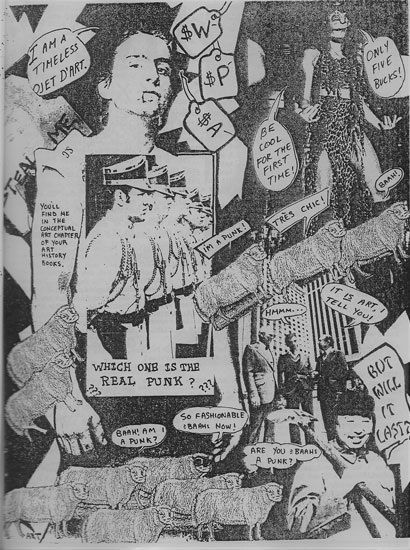
"THE ONLY FANZINE YOU CAN DANCE TO"
The Sweet, Short Life of Washington DC's First Punk Fanzine
by Michael Layne Heath
(August 2022)
Suburban Maryland, 1976: I was this smart, shy, culturally inquisitive kid, especially when it came to music, devouring every issue of Creem and Hit Parader I could get my pulpy palms upon. I enjoyed Creem's irreverence, and that their stable of scribes like Lester Bangs were almost as much rock stars as anyone they wrote about. In fact, I definitely took to heart their ad soliciting outside contributors: "No one writing for this magazine has anything you don't have."
In the case of Hit Parader, this was a time where New York music mavens Lisa and Richard Robinson were its editors. They attracted all these amazing writers like Lenny Kaye, and even scenesters like then-Wayne-now-Jayne County, Lance Loud and Richard Hell. Lisa was very vocal and literate about what was going on the blossoming New York underground rock scene of the time, effusively raving about the likes of the Ramones, Television, Blondie, and this band fronted by a poet (hmm) named Patti Smith. Which reminds of another mag I enjoyed: Rock Scene, also helmed by the Robinsons, was kind of a hipper version of 16 magazine. It was all photos, with features like "The Ramones Do Laundry" and "David Byrne Goes Grocery Shopping."
The thing was, you couldn't hear a lot of the stuff that I was reading about on the radio in the mid-'70 's, although there was for a time an excellent show on local Top 40 station WINX called Heavy Metal Thunder. It was hosted by Skip Nelson, aka Skip Groff (RIP), who later went on to rule both the supreme Metro area Punk/Wave record shop Yesterday And Today, and local label Limp Records.
Then I discovered the Georgetown University FM station WGTB, playing everything that their commercial alternative rock rival WHFS wouldn't touch with a ten-foot granola bar, including the latest Glam, Progressive and proto-Metal rock (a detailed history of 'GTB's checkered existence can be found here: https://washingtoncitypaper.com/article/274469/radio-free-georgetown/).
Crucially, 'GTB hosts like Steve Lorber, on his Mystic Eyes program, were playing what folks like the Robinsons were covering. These were the first stirrings of what would become the American underground, encompassing New York (via compilations showcasing the Max's Kansas City and CBGB clubs, the first singles by Television and the Ramones), Cleveland (bands like Pere Ubu), Boston and other locales. Lorber was also connected with a young local band, one whose debut EP he played heavily on Mystic Eyes, called the Slickee Boys. Having just gotten my driver's license and my first car, I went to see them play a little club outside Langley Park, Maryland.
Their look was very un-arena rock god like, especially the guitar-slinging beanpole with long, dark hair and Ming the Merciless goatee, who I discovered was one Kim Kane. As for their sound, it was fast and punchy, covering '60 's British and American garage nuggets, including local heroes The Hangmen 's "What A Girl Can't Do". I thought they were great, and I started hanging out with Kim Kane at his place in Bethesda after school some afternoons, where he would play me all his latest vintage garage and psych finds, as well as what vinyl he could cop from the current underground crop.
One of the more notable was a band out of the Midwest - Bloomington, Indiana to be exact - called The Gizmos. They were led by Kenne Highland, who as it turned out had enlisted in the Marines and was stationed at a nearby base in Virginia. Kenne had also discovered the Slickees via WGTB and Lorber's show, and soon became fast friends with Kane and company, and thus myself. Kenne would play a crucial role in a life event to be explained later.
Meanwhile, distinct rumblings of a similar nature were being heard across the pond as well. I had already read in Creem what I later discovered was a reprint of British rock writer Neil Spencer's NME profile of this band called the Sex Pistols: the infamous 'we're not into music, we're into chaos' piece.
My printhead was getting expanded as well. Through an ad I placed on WGTB's community bulletin board, I met a fellow music fanatic named Jeff Zang. He was about my age, but was already subscribing to your more niche-driven rock mags like Greg Shaw's Bomp!, as well as one that Steve Lorber would regularly refer to on Mystic Eyes, called Trouser Press ("America's Only British Rock Magazine"). Jeff would loan me copies of both, and I really got into them.
In the autumn of '76, I started college at the University of Maryland at College Park. It was there I discovered a newsstand in the student union that carried two-week-old copies of the British music weekly Melody Maker. As luck would have it, the first issue I saw had the now-famous cover of the Sex Pistols trying to stop/joining in an audience punch-up at a London rock club. It was in a subsequent issue of MM that I read a feature about a young Londoner named Mark P., editor and creator of Sniffin' Glue, the first independently produced magazine - 'fanzine' - covering the ongoing London underground music scene, or what was starting to be called - by the mainstream press, anyway - 'Punk Rock. '
By this time, the first Punk records were coming out of England - The Damned's "New Rose," the Pistols' "Anarchy In The UK" - and Steve Lorber premiered them all on his 'GTB show. Between all of that and what was happening locally with the Slickees, I was motivated to submit an overview/introduction to UK and US Punk music to the University of Maryland's daily newspaper The Diamondback. They rejected it, saying Punk was a fad and would be over in six months. I then submitted the same article to the University's 'alternative' arts monthly, The Argus. They also took a pass.
In the wake of such rejection, I got to thinking about Mark P.: this guy who was a bank clerk and a total music fan, not seeing what he was into represented as vividly or passionately as he felt it should be by the mainstream music press. So he did it himself with Sniffin' Glue. As for me, I had written record reviews for my high school newspaper, highlighting bands that totally went over most of the student body's heads: the New York Dolls, Roxy Music, the Dictators. And from what few issues I had read of Sniffin' Glue, via good old Kim Kane, Mark didn't seem any better or worse a writer than I.
I had also been aware of this guy from Northern Virginia, Norm DeValliere, who did a zine called It's Only A Movie, devoted to the more arcane end of the British rock spectrum - Henry Cow, Slapp Happy - in addition to the artier New York likes of Patti Smith.
And so, between the example of Mark P. and that long ago nudge in Creem, in March of 1977, I said, "I'll do it myself." I went to the campus bookstore on Route 1 and bought a pack of mimeograph paper.
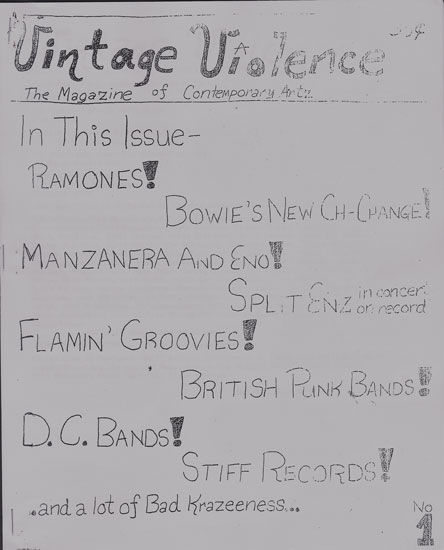
Armed with naught but my trusty electric typewriter, I knocked out all this raving rock blather that became the first issue of what I named Vintage Violence. I called it that because I was--and still am--a huge John Cale fan. I then snuck into one of the U of Md. faculty offices that had a mimeograph machine and ran off about 50 copies. I proceeded to send them to the folks at Trouser Press and Greg Shaw of Bomp!, got them into a few local record stores, and hawked it at the few Punk music gigs being put on at sympathetic venues like The Keg, a dive bar at the edge of Georgetown in Washington DC.
As this was the time when being a Punk fan almost demanded a name to match, I chose Mike Livewire, after a suggestion made by Steve Lorber about a name for the band Jeff Zang and I were trying to put together.
The second issue came a few months later, also on commandeered mimeograph, spotlighting Iggy Pop's comeback with The Idiot; I also started getting other people involved writing, like Howard Wuelfing, a recent transplant from New Jersey playing bass in a new local underground rock combo called The Look, sharing bills with the Slickees.
For reasons too personal to elaborate on, I left home in August of '77, staying at a relative's house in Los Angeles for about six weeks. During this time, I made regular pilgrimages to the Bomp! record store in the Valley, where I got to hang with the aforementioned Greg Shaw, as well as likeminded music folk like the future ruler of Frontier Records, Lisa Fancher, and then-writer for L.A.'s Back Door Man fanzine and future Angry Samoan, Gregg Turner.
And after meeting with a promo person at Sire Records whom I plied with copies of my zine, I finally got to see The Ramones for the first time, at the famed Whisky A Go Go. I got comped for the night - two whole sets - my ears rang for the next thirty-six hours... and I didn't mind a bit.
There was a third issue of VV planned for the summer before I split for L.A., but never got around to doing it, so I just skipped it and went to number four, which came out in Christmas '77. I had by then ditched the mimeo and went for the slightly more improved Xerox means of production; it still looked pretty rough, if maintaining the enthusiasm of previous issues.
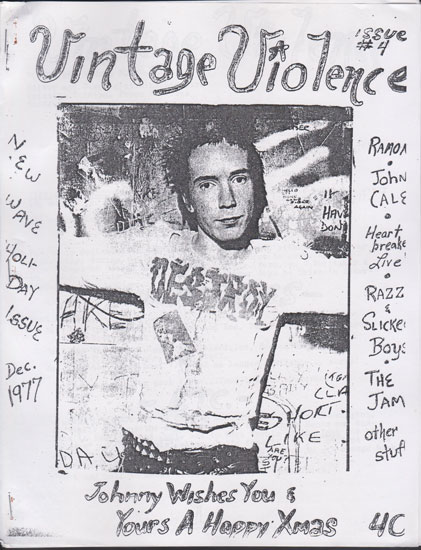
I reconnected with the Slickees, as well as those who I had met during their regular gigs at the Keg, and even cajoled into writing for VV. There was Patricia Ragan, a mad Joey Ramone fan who had been featured in a piece about the local Punk scene in The Washington Post. There was Joe Sasfy, clinical psychologist, enthused new music fan and scribe for the local alternative rag The Unicorn Times.
There were also other bands getting in on the action: besides The Look, there was Razz, a relative veteran combo, one that had played such prestige gigs as supporting Roxy Music a few years previous, coming back from a short hiatus. Razz's lead singer Michael Reidy was a sight to behold: imagine a young James Cagney sporting a mullet, commanding any stage he occupied with a stagecraft and work ethic to rival that of James Brown. Razz were clearly energized by the new rock energy, cranking out no-nonsense, meat-and-potatoes beat noise not unlike the early Flamin' Groovies or the Stones in their prime.
There was also The Controls: a scrappy but artsy garage/punk quartet. They were fronted by an animated, baby-faced blonde gent calling himself Nicki Butane. Known to his family and friends as Roddie Frantz, he was the kid brother of Chris Frantz, drummer for New York underground mainstays Talking Heads. Bands from upstate were also staking their claim: Judie's Fixation from Annapolis, Charm City's own Ebenezer and The Bludgeons.
Kenne Gizmo Highland was also still around on the scene, writing songs like "Jailbait Janet" that would later be covered by The Slickees, and doing the occasional show of his own. I even got roped into one of his performances, along with Jeff Zang and Kim Kane's younger brother Thomas. After a rehearsal at Kim's house lasting all of two hours, we opened for The Look one night at the American University student's pub, calling ourselves the Blank Generation All Stars. In retrospect, the noise we generated might charitably be described as our equivalent of Siouxsie And The Banshees' shambolic debut at London's 100 Club Punk Festival.
Another Highland gig proved to be a crucial step in the development of Vintage Violence. With fellow rock fanzine pals, including Solomon Gruberger who did a zine called O. Rex, Highland managed to get a gig together, with the Slickees, at an all-purpose hall on his Quantico Marine base. Among the several dozen attendees was a young couple who had somehow gotten copies of Vintage Violence, were aware of and liked it. They turned out to be Rob Kennedy and his partner Catherine 'Caki' Kallas. Rob and Caki approached me, we got to talking, and soon started corresponding and hanging out at gigs. They were slightly older than me, by a couple years, but had so much richer life experience than I did at the time, being this green suburban kid from Burtonsville, Maryland. Rob was from New Jersey, and I was jazzed that he had seen The Stooges in New York City on a number of occasions. Rumor had it that Rob even used to hang around with these guys who were part of a radical NYC street gang - not unlike Detroit's White Panthers - called The Motherfuckers.
Rob and Caki saw something in what I was doing with my zine and said, "We'd really like to contribute." This became the team that did the last two issues of Vintage Violence. They brought so much experience to the table and to the page, Rob being a great writer and Caki with her artistic, cartoon skills.
This was a period where we were on fire, totally passionate about the new music coming over from all points: D.C., England, New York, Cleveland, San Francisco, L.A. And being a bit more financially together than I was at the time, when I would go over to their place, they would play me all manner of fresh tuneage. "Oh, listen to this new Dangerhouse record. Listen to 'Final Solution' by Pere Ubu. Listen to 'We Are The One' by the Avengers."
The process of doing the mag when we were together would involve many hours sitting around the kitchen table in their flat in downtown Northwest D.C., off Dupont Circle. Rob and I with an electronic typewriter, and Caki her drawing board, fueled by endless amounts of strong coffee. We would just type this stuff out with whatever record we were reviewing blaring, doing a sort of "first thought, best thought" kind of thing. And then hand it over to Caki, where she'd do her thing on top of it.
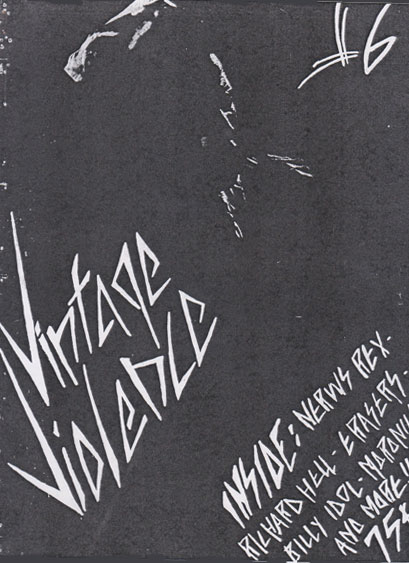
If you look at those two issues, it really comes through what mags we were inspired by. There was of course Sniffin' Glue, for its rough Xerox look and unfussy, spontaneous criticism and critique. But then there was also NYC's Punk magazine for both its look and for John Holmstrom's genius cartooning. In what became our final issue, we even had a comix section drawing from a pool of great local artists, such as Dan Steffan, and an excitable scenester and aspiring guitarist named David Arnson, who would go on to form the Insect Surfers.
Thirdly was a zine that Rob and Caki turned me on to, Search and Destroy from San Francisco; theirs was a more thoughtful, artistic, urban hipster approach. We actually even took more than their attitude for VV; the collage on the cover of issue #5 included a rendering copped from a photo of Iggy Pop featured in an issue of S & D (belated apologies, V. Vale).
We were well on a roll by mid-1978, printing upwards of 300 copies of each issue, now using the far more advanced offset method via a local DC printer. After a Patti Smith concert, I managed to get copies to Lenny Kaye, who gave it a glowing writeup in his Doc Rock column for Rock Scene: '75 cents and worth it.' At a laughably conceived 'Punk Art' exhibit at a DC gallery, I gifted John Holmstrom of Punk Magazine with the latest issue of VV. He was enthusiastic until he saw the rave review Rob had given the new LP by Punk's arch nemesis Wayne County.
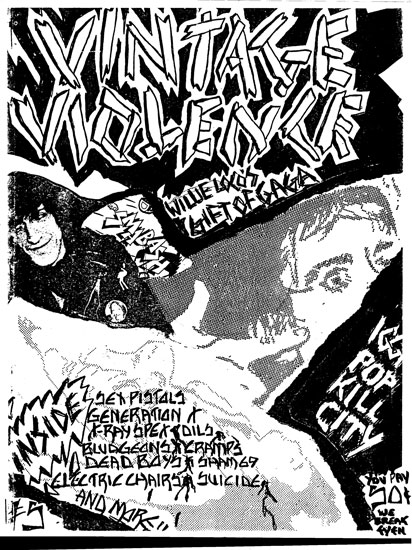
In this way, Vintage Violence got a bit of a name on the local DC/MD/VA music scene; one that got us eventually banned from the then preeminent club regularly hosting Punk/Wave bands, a feat that was our most notorious moment by far.
There was so much suspicion and disdain from the local mainstream rock crowd that there were precious few places for bands in the Punk/Wave style to play. There was the Keg and the occasional college gig, but otherwise that was about it, unless you went up to Baltimore Civic Center, like Rob and I did, to see Iggy on the Lust for Life tour with the Ramones opening, fall of '77.
Along comes this guy named Paul Parsons, who decided to open up his restaurant, The Atlantis, located at 930 F Street in downtown DC, to live music. All the local bands that wanted to play original music - or anything that wasn't Top 40 or the dreaded disco - were thrilled to finally have a regular venue. Even better, the club attracted the occasional out-of-town combo to play, such as the double bill of Cleveland's Pere Ubu and Minneapolis' Suicide Commandos, a package tour promoting the short-lived Blank Records label (the guy who ran Blank even showed up with the bands, a very pleasant and knowledgeable music fan named Cliff Burnstein, who would rise from the Blank Records ashes to manage, among others, Def Leppard and Metallica).
Things soon soured, however, when it was perceived by both bands and fans that the people running the club were opportunists, ripping bands off for various reasons or infractions. It ultimately came to a head when The Cramps played The Atlantis, having already played places like Bethesda's Psychedelly to enthusiastic response. Parsons was evidently freaked by their psychobilly antics, later overheard to observe that "The Cramps are not healthy" and cancelled the last night of a three-night engagement, shorting the band for what they were supposed to be paid. Rob was at the show and, at our next 'staff meeting,' ran the whole story down to us and insisted that we need to bring this to our readers' attention.
So we wrote about it in Vintage Violence, thus getting the word out. Shortly thereafter, when Lance Loud and the Mumps came to play the Atlantis, halfway through the evening, I was 86d from the club by security under the most specious of circumstances (some friends and I were passing a joint around in the back of the club, and it got handed to me just as the security guard approached). When, on the urging of Rob, Lance Loud attempted to intervene on my behalf to get me back in, one of the club managers told him, "It's lucky we let him in at all, after what he wrote about us in that magazine of his." A few weeks later, Rob suffered the same treatment, though this time the security guy actually put him in handcuffs before booting him out the door.
Amazingly enough, once the jungle telegraph got revved up, our mistreatment galvanized the local music community, thus initiating a boycott of the Atlantis among clubgoers and bands both local and from out of town. After a number of months, Parsons and cohorts shut the Atlantis down. And in early 1980, Jon Bowers and his wife Dodi took over the space, christening it the 930 Club; I was at its opening in May of 1980, with NY punk jazzbos The Lounge Lizards topping the bill. The 930 has gone on to earn a justified rep as one of the foremost music venues in the DC Metro area, and for that matter, the entire country.
Why did Vintage Violence cease publication after six issues? Nothing terribly dramatic, really. In a way, much in the same manner of (here's those names again) Mark P. and Sniffin' Glue, it just ran its course. Time, resources and funds were in limited amounts among us three to begin with; add to that Rob getting more involved with his own music, namely the great avant-garage combo Da Chumps. In my humble opinion, they really were as close as DC ever got to a NY No Wave type band on the level of James Chance's Contortions; check out their retrospective CD The Problem With Saxophones for ample evidence.
Rob has since gone on to pursue a fiercely independent musical path, heading to NYC after Da Chumps' implosion to churn up a big noise with his dirty blues/punk duo The Workdogs. More recent projects include the Jam Messengers and (in keeping with his VV nom de punque Sirhan's Victim) The Robert Kennedy Assassination.
Beyond that, for me personally, the new, younger crowd coming onto the scene was, with few exceptions, one I could neither relate to nor comprehend. I couldn't relate to Rastafarians from Landover, or willfully aggressive, skinhead sociopaths. I would imagine people like Exene and John Doe felt similarly about the skaters and surfers from the South Bay of Los Angeles; likewise John Lydon in England, observing the rise of the Oi!/Mohawk subculture there.
Besides which, other local folks were happily picking up the fanzine slack, and I was even lucky to write for a few of them: Mary Levey's Infiltrator, Howard Wuelfing's Descenes, Xyra Harper's Capitol Crisis (which chronicled the early DC Hardcore scene), WDC Period, Thrillseeker, Zone V, Now What? , Greed, and my ultimate zine home, Barbara Rice and Bill Wort's Truly Needy.
But when it came to the emerging, loud-fast-rules Hardcore Army, I was a conscientious objector. The more cerebral, edgier, sonically varied sounds later termed Post-Punk were beckoning me, and I gladly answered their siren's call.
(and nouvelle vagued)
D.C. Before HarDCore - A Baker's Dozen
The Slickee Boys (MK 1 - featuring Martha Hull) "What A Boy Can't Do"
Razz "C. Redux"
White Boy "I'm So Straight"
The Nurses (feat. Howard Wuelfing) "Hearts"
Urban Verbs (feat. Roddie Frantz) "The Only One of You"
Insect Surfers "Into The Action"
The Rudements "Imagination"
Da Chumps (feat. Rob Kennedy) "Jet Lag Drag"
The Shirkers "Drunk And Disorderly"
Tru Fax And The Insaniacs "Washingtron"
Tiny Desk Unit "Take Me To Paris"
Velvet Monkeys "Everything Is Right"
The Slickee Boys (MK 2 - feat. Mark Noone ) "Forbidden Alliance